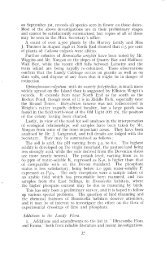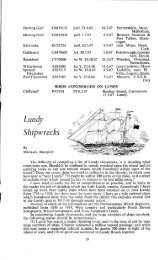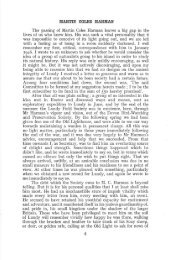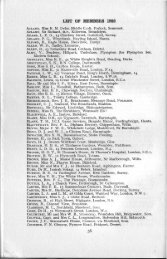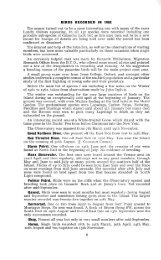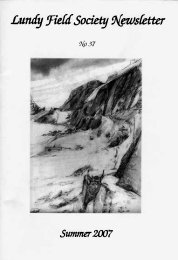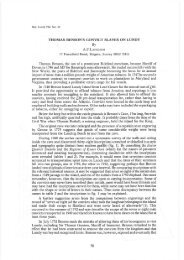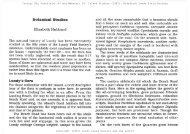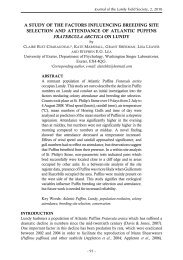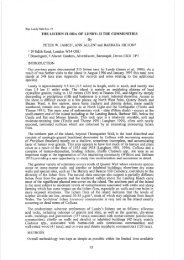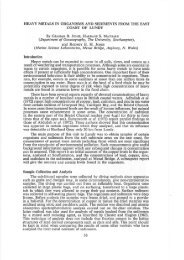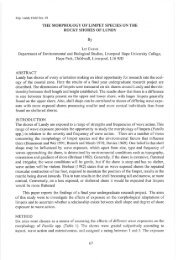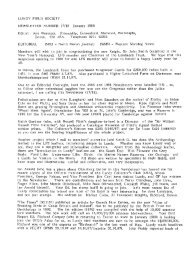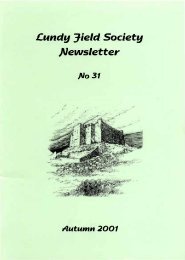THESYMBOLICORIENTATIONOFST.HELENA'SCHURCH,LUNDY ...
THESYMBOLICORIENTATIONOFST.HELENA'SCHURCH,LUNDY ...
THESYMBOLICORIENTATIONOFST.HELENA'SCHURCH,LUNDY ...
- No tags were found...
You also want an ePaper? Increase the reach of your titles
YUMPU automatically turns print PDFs into web optimized ePapers that Google loves.
Rep. Landy Field Soc. 43<strong>THESYMBOLICORIENTATIONOFST</strong>.<strong>HELENA'SCHURCH</strong>,<strong>LUNDY</strong>ByR. W. E. Fartah4 Railway Cottages, Long Marton, Appleby, Cumbria CA16 6BYThiTRODUCTIONANDIDSTOruCALBACKGROUNDWilliam Hudson Heaven died in 1883 and was succeeded as owner of Lundy by hiseldest son, the Rev. Hudson Grosett Heaven, who was educated at Oxford, took holyorders and became a teacher. He had become the headmaster of Taunton Colle~eSchool, combining teaching with preaching in local parishes, but gave up teaching m1863 to return to Lundy where he continued the legacy of his father in exercising acaring guardianship over the island This meant tending to the spiritual needs of thepopulation which then numbered 200 to 300 souls, many working for the GraniteCompany. He also taught in day schools and Sunday Schools for the island children. Hewas an 'omnivorous reader' and was nicknamed 'the philosopher', as islanders oftenvisited the house to borrow books from the vast library (M. Langham 1980,14). Thetrees which add to the beauty and have completely transformed the valleys ofMillcombe and Sl John were planted by him (A and M. Langham 1984, 43). Acontinental Baron had _previously made him an offer with a view to turning the islandinto a Monte Carlo; he declined, stating that he had, ''no intention of allowing Lundy totum into a gambling hell" (ibid., 69); a man who plants trees places his treasure inanother heaven.Lundy at this time was regarded as extra parochial and the patronage was assumed bythe owner. In 1864 the Rev. Heaven was licensed as curate in charge of the island andhad the courtesy title of Vicar in 1886; from that time services were held on the islandevery Sunday (A and M. Langham 1984, 109). There has been some criticism of theRev. Heaven s~esting he was a man typical of his times whose ideas were somewhatout of keeping wtth the needs of Lundy.-The church of Sl Helena is often looked uponas an eccentricity, the building having an incongruous appearance. But if he is to bejudged by deeds alone, there can be little doubt that he was a great benefactor and aman of deep religious principles to which he was fully committed Altho~ he dideventually realise his lifelong ambition in building the consecrated church of Sl Helena,the short history of religious worshop on the island during his time shows that his mainconcern had always been the spiritual needs of the community and preaching the Wordof God.The first services were held in a iron built hut which was erected by the GraniteCompany on a site in the High Street which is now used as a sheep-dip; this buildingfulfilled many of the functions of a parish hall but was dismantled when the GraniteCompany left in 1870. Services were then held in "The Big House", which was thesouth wing of the farmhouse, or in "The Villa" (M. Langham 1980, 40). At this timethe Heaven's finances were insufficient to build a stone church, but a Mrs Langworthy(Sarah Heaven), a distant cousin, together with her sisters, came forward with donationswhich enabled the iron church of Sl Helena's to be buill This was a pre-fabricatedbuilding made of corrugated iron with a spire, and was erected in eight days. It was builtat the top of Millcombe Valley near the wall of what was the hotel garden. It wasdedicated on 20th August 1885 by Bishop Bickersteth who described it as a "corrugatedirony". The building was only dedicated and not consecrated so it was not possible formarriages to be celebrated there (A and M. Langham 1984, 109). This church continuedin use until the granite church was built in 1896.Tiffi CHURCH OF ST. HELENAThe granite church of Sl Helena was built by the llfraoombe firm of Britton andPickett, the foundations being laid in 1895 and the building completed in 1896. Much ofthe granite used in construction was taken from the then ruinous Quarter Wall Cottages.78
The building of the church rep-esented the culmination of a lifetime's ambition; a plaquein the porch subscribed by members of the Heaven family commemorates thisachievement. The words were chosen by Marion C.H. Heaven:"In loving memory of Hudson Grosett Heaven, Priest, Lord of the Manor of Lundy,who died in 1916 having accomplished the dream of his life by erecting this church tothe Glory of God."This dream was made possible by a legacy left by Mrs Langworthy who was thewidow of a Birmingham millionaire. Most of her fortune was left to the Heavens ofLundy, with the request that they build a {>Toper church to replace the corrugated ironbuilding (A and M. Langham 1984, 110-11).The church is an example of the Victorian Gothic Revival. The architect was Mr JohnNorton F.RI.B.A, who had erected more churches in the west of England than anyother professional practitioner of his day. He designed the church to have a fairly ornateappearance but at the same time sturdy eno~ to withstand the harsh island climatewith its fierce gales (Fig.1). Today the church IS in a sad state: the ravages of storms arecausing increasing p-oblems with encroaching damp, and hardly a winter passes withouttiles being ripped off the roof; the bells were removed from the belfry because they hadbecome too dangerous to ring, and the apex of the altar window was sucked out in agale in the 1950s, the dressed stone formmg the apex falling near the vestry (Thackray1989, 156). This has diminished the aesthetic appeal the proportions of the church oncehad when looking down the aisle towards the altar.The church has a nave, chancel, vestry and tower. The roofing comprises stone tilesfrom the stone quarries at Tetbury, Gloucestershire, the tiles therefore being encrustedby myriads of small, beautifully shaped and coloured fossilised seashells. The ridges areof red terracotta, and the angles of the tower and the turret are defined by projectingcarved gargoyles. Inside the church the inner wall is of Bridgewater brick, relieved bycourses of white Marland and black Staffordshire bricks. The windows and doordressings are of Doulting stone, and encaustic tiles are laid in the nave passage and inthe chancel. The nave has a length of c. 16m and is fitted with oak benches with seatingaccommodation for 160 worshippers.Prior to the gale of the 1950s, when the altar window was damaged, a visitor'sattention was immediately focused on the altar by the pleasing symmetry of the archwhich divides the nave from the chancel and the similar proportioned arch of the altarwindow which echoed the former. At the altar is the reredos which is the work of HarryHems, a well-known sculptor of Exeter, and is undoubtedly the central artistic attractiontogether with the altar window. The altar is of polished veined alabaster and the mainportions of the reredos are divided into three by columns of polished Purbeck marble.The sculptures are in exceptionally high relief and depict, from left to right: ThePassover, The Last Supper and the Scapegoat in the Wilderness. Above the reredos isthe stained glass window by Gayton and Bell; the north light represents the AngelGabriel, the Annunciation of the Virgin and the Angelic vision of the shepherds, and theappearance of the Magi. The south light shows the Angel rolling away the stone fromthe Sepulchre, the visitation of St. Thomas and the Ascension of the Lord The centrelight depicts the agony in the Garden, the Crucifixion and the entombment, with the restof the window filled with the Lord seated in Glory surrounded by the Heavenly host. Allthree panels together depict the complete sequence of Christ's life, the birth, death andresurrection (Anon 1972, 6-8).The church tower is 21m high and 6m square. On the north-east face of the tower is alarge statue of St. Helen also by Harry Hems. The face and headdress. were carefullymodelled from a medal of St. Helen now in the British Museum and said to be one ofonly two coeval medallions of her in existence.The Empress Helen was the mother of the first Christian Emperor Constantine. St.Helen is chiefly associated with the discovery of the cross on which Christ was crucifiedand the cross is her emblem in art (the statue here shows her holding the cross in herarms). She is thought to be a native of Britain though there is no historical justificationfor this. The Emperor Constantius, her husband, repudiated Helen for political reasons,79
Fig. 1 : The church and standing stone to its north-west.80
namely her faith in Christianity. This in turn was to influence her son Constantine, whotreated his mother with the greatest respect, and was to result in toleration beingextended towards Christianity (Attwater 1973, 166).Initially Constantine, like his immediate Imperial predecessors, worshipped theUnconquered Sun. In AD 312 when he met Maxentius at the Milvian Bridge to fight forthe Empire, Constantine had a vision of the cross superimposed on the sun and heard lhewords, "triumph in this". He adopted this double motif for the shields of his soldiersand won the victory. This experience led to his conversion to Christianity, though hismother is generally acknowledged as being the formative influence in his conversion.Even after his conversion, however, he still retained his old allegiance to lhe sun cult,but this gradually merged with that of Christianity (Green 1991, 50). Constantinedeclared the day on which Christ rose from the dead a public holiday and called it ''lheSun's Day"; northern Europeans followed this example with such names as Sunday andSonntag.The consecration of St Helena's Church by the Bishop Bickersteth of Exeter, tookplace on June 7th 1897. The church was handed over to the Royal Church Commissionon the same date, which was probably put of the agreement reached ~or to it beingconsecrated by the Bishop. A full choir of men and boys from St. Sidwell's, Exeter,dressed in their surplices, were led by the cross bearer, Harry Hems from the LandingBeach up the precipitous road to the church. The ecclesiastical party consisted of clergyfrom parishes from the South-West and South Wales. The church was filled tooverflowing and there was music composed especially for the occasion. The crossingfrom the mainland in the pleasure steamer Brighton, had been a rough one with many ofthe passengers suffering from sea-sickness. The Bishop humorously acknowledged hisconversion to lhe belief in purgatory by his experience of what it was necessary to gothrough in order to reach "the Kingdon of Heaven" (Anon 1972, 6-8).It has been suggested that the dedication of the church to St. Helen was the result of amistaken notion that the dedication of lhe old chapel was a latinised form of St Helen,when in fact it was the celtic saint, St. Flan. This may not be correct and the dedicationto St. Helen might be more purposeful than was at first supposed.THEOruENTATIONOFTHECHURCHThere is some mystery concerning the orientation of St. Helena's church, which doesnot conform to lhe usual practice for ecclesiastical buildings of east-west alignment. Thishas long been the subject of speculation with many different theories being expressed.The church is said to have been built in its prominent position at the top of the island soit would serve the mariner as a daymark. The tower is marked on navigation charts asconspicuous, but this consideration would not have affected its orientation. The land areasurrounding the church wasn't restricted either, so lhis also was not a factor. Othersuggestions include the unexpected discovery of sandclay when layin!! the foundations,causing the builders to alter the axis, and that the axis was determmed so as to runparallel to the road in order that the entrance porch afforded shelter from the prevailingsouth-westerlies. Last! y that the church was so built that the front and the most desirableaspect was the first to be seen when approaching the building from Millcombe.Although all these factors are probably true, and some were taken into consideration, Isuggest that none were the primary cause for lhe orientation. The mystery deepens whensearching the most likely archive sources. The Diocesan Record Office and the DiocesanRegister at Exeter had no relevant information on the orientation and neither does thearchitect's plan of the church (Plate 1, at rear). The Devon Record Office could find nofaculty papers for the building of the church and there was no reference to the churchamongst the main series of volumes where such information is usually registered. Giventhe _independent status of Lundy, which was fiercely defended by the Heavens, it islikely that a faculty wasn't needed for the building. But most surprisingly of all is thatthere is no mention in the Heaven diaries and papers concerning the building of thechurch, even though lhis was the dream of the Rev. Heaven's life. Langham suggests thereason for this was that the Heaven family disapproved of the Rev. Heaven spending allof Mrs Langworthy's bequest on the building on an unsuitably large church, when themoney could have been used to alleviate their dire financial state (pers. comm.). There81
seems to have been a conspiracy of silence; there could have been genuine anxietiesover permission being given for the church to be consecrated.On the north-east face of the tower below the clock is the legend, "TEMPUS SATORAEI'ERNITATI" ("Time is the sower of eternity"), and the cycle of time sowing theseeds of eternity was indeed built into the very foundation of the church. I firstsuspected the unique orientation of the church from a passage in Myrtle Langham's ALundy Album (1980). On a page showing a photograph of "A ~cnic on the occasion ofQueen Victoria's Jubilee, 1887", the passage beneath reads, 'On June 20th a specialcommemoration service was held in the new church, which had been consecrated by theBishop of Exeter three days before" (Queen Victoria had begun her reign on June 20th).The date of the consecration is a mistake as this was carried out on June 7th, but thedate of the commemoration service on June 20th was familiar to me through my workon megalithic astronomy; it is the eve of the summer solstice.To test the accuracy of the orientation I needed to ascertain the true declination of thesun on the horizon along the axis of the church. I took magnetic bearings by prismaticcom pass along the centre of the aisle in both directions, and as a precaution againstmagnetic anomalies inside the church, took the same readings outside the church usingthe apex of the roof as a sightline (Fig. 2). The altitude of the horizon was ascertainedby theodolite and Gerald Hawkins calculated the declinations (see Table 1).TABLE 1: ORIENTATION OF ST HELENA'S CHURCH, <strong>LUNDY</strong>MAGNETIC SKYLINE DECLINATION OBJECTBEARING ELEVATION ON SKYLINE1.309° 30 +22.1 ° Midsummer sunset130° 0.25° -20.5°2.309.5° 30 +22.3° Midsummer sunset129° 0.25° -20.5°Group 1 are the readings taken from outside and group 2 those taken inside. Theresults show that the orientation for the midsummer sunset azimuths have a declinationerror of 1.4 degrees and 1.2 degrees, the sun 's declination at midsummer being +23.5degrees. However, the azimuths are close enough for the symbolic orientation tofunction, the sun in fact setting just to the north. Standing in front of the altar lookingnorth-west, one would see the midsummer sun setting in the two arched windows andwas the reason these were panelled in clear glass. I would also suggest that theorientation explains the reason for the incongruous height of the church, for thesymbolic beauty of this event would have been aesthetically diminished in a smallerchurch. The rose window above depicts St. John the Baptist, whose feast day was June24th, the date of his birth and old midsummer's day. The rose window is so-calledbecause of its resemblance to a many petalled flower and is recognised as a solarsymbol expressing eternity (Wood 1976, 22-3). The words which read clockwise aroundthe rose window seem to have been carefully chosen to describe this experience of light;they are written in seven of the petals:1. Of his fulness have2. we all received,3. and grace for grace.4. For the law was5. given by Moses, but6. grace and truth came7. by Jesus Christ. (St. John. i, 16-17)82
NFig. 2 : The Midsummer solstice orientation of St. Helen's church.83
In the central window John the Baptist is holding a flag with the words,"ECCE-AGNUS", which means "behold the lamb". The lamb with the flag in the toppetal of the rose is the ecclesiastical symbol of resurrection (Cooper 1978, 94).The reality behind the symbolism of this orientation came dramatically to life duringthe 75th Anniversary service of the consecration of the church on June 7th 1972,although the date is two weeks before the solstice when the sun reaches its mostnortherly standstill. The service was held at 20.45 hrs, approximately thirty minutesbefore sunset. I was informed that the reason for this late time was so people could havetheir evening meals. I have not yet been able to establish what time the commemorationservice was held in 1897, but this late hour would have been exactly right for theorientation to be effective and witnessed by the congregation. John Dyke, who lived onthe island from 1970 to 1975, was in church for the Anniversary service and recalls theevent, saying, "the dramatic phenomenon which clergy and congregation experienced,the blaze of golden sunlight on the altar and reredos was a quite unforgettable event". Aphotograph first published in Vo. 9 of The Illustrated Lundy News and LandmarkJournal, shows this "unusual blaze of light on the altar" (Fig. 3). The occasion of theconsecration of the church also coincided with Whitsun, the season of Pentecostcommemorating the descent of the Holy Spirit to the apostles of Jesus. Whitsun literallymeans "White-Sun-day"; the orientation of the church to the sun here representing theHoly Spirit makes perfect symbolism.The astronomical orientation of the church with its inherent symbolism of light istheologically rational, as Christ called the Baptist a "burning and shining light", whowas the forerunner of the true light. The Baptist said of Christ, "He must increase, but Imust decrease" (John.iii,30). The anology applies to St. John's day, when at the summersolstice as the turning point of the year, the sun's power decreases. The nature of thisorientation is such that the winter solstice, December 21st, is indicated in the oppositedirection, though the error here in declination is 3 degrees. In astronomical terms thewinter solstice marks the point when the sun increases and winter ends at the vernalequinox on March 21st. Both these have been incorporated by the early church into theChristian calendar: the winter solstice as the birth of Christ, and the vernal equinox isused for fixing the date of Easter, which is the nearest full moon to the spring equinox,this being the time of the death and resurrection of Christ. The solstitial birth of Christand the solar association of Christology were described by St. John Chrystom in histreaties, De solstitiis et aequinoctiis: "But the Lord, too, was born in wintertime, on thetwenty-fifth of December, when the ripe olives are pressed in order to produce the oilfor anointing the chrism. They also call this day the birthday of the Unconquerable One(Mithras). Yet who is as unconquerable as our lord, who overthrew and conquered deathitself? He himself is the Sun of righteousness of whom the prophet Malachi spoke. He isthe Lord of light and darkness.''This seasonal cycle is depicted in the three lights of the altar window. The wintersolstice sun first rises in the left-hand light which depicts the birth of Christ. Just belowthis window the axis centres on the head of Quist in the centre of the reredos, the LastSupper. Here, behind the head of Christ, sculptured in low relief and not easilydiscernible, is a magnificent halo indicative of solar power and the sun's disk (Fig. 4).The halo was originally an attribute of sun gods and symbolises divine radiance andenergy, the spiritual power and force of light. The cruciform halo is specificallyChristian (Cooper 1978). The sculpture is reminiscent of Constantine's vision of thecross superimposed upon the sun. Below this altar window but on the outside of thechurch facing the direction of the rising winter solstice sun is a stone inscribed:TOTHEHONOURANDGLORYOFGODAND IN PIOUS MEMORY OF ST. HELENTHIS STONE WAS LAIDTHE 5TH DAY OF JUNE 1896.These themes are continued in the pulpit and dwarf screen which separates the navefrom the chancel. The pulpit has a sculpture of the Sermon on the Mount and the text,"Thy word is a lantern unto my feet" (Psalm 119, Verse 105). This is only half the84
Fig. 3: The 'Blaze of light' experience. This photograph originally appeared in TheIllustrated Lundy News and Landmark Journal.85
Fig. 4: The Head of Christ with halo behind; a sculpture in the centre panel of thereredos.86
verse though; the rest reads: "and a light upon my path". From the pulpit can be seenthe Old light on Beacon Hill framed in the right hand northwest window. The dwarfscreen has four medallion sculptures two on either side of the aisle; these are repeatedon the other side of the screen. They oonsist of Christian emblems superimposed onsolar symbols. The first on the left is the first three letters of the name Jesus m Greek.The second is the star of David (Jesus was of David's line) which also signifies the OldTestament and, by strange ooincidence, was adopted by the Zionist organisation at thefirst Zionist Congress in 1897, the year the church was built The third sculpturerepresents the chi-rho which was adapted from a symbol for an ancient Chaldean skygod by Christianity (Fig. 5). This was the emblem of Constantine and was placed on hisstandard and on the shields of his soldiers (Cooper 1978, 92). The "Giant's Stone",which is now situated outside the Tavern, is a cist oover to the "Giants' Graves" whichwere discovered when the foundation trenches were laid for the new farm buildings. It issaid that this stone carries on its surface a chi-rho symbol, formed by a number of holeswhich when joined form a rough representation. Loyd relates that the Rev. Heavenexpressed a wish that it might serve as his tombstone (Loyd 1925, 18). The chi-rhosymbol is frequently depicted with the Alpha and Omega symbols, examples of whichcan be seen above the arch directly overhead Alpha and Omega represent the totality,the beginning and end, day and night, light and darkness (Cooper 1978, 10). The fourthand final emblem is the simplest form of cross, the crux quadrata or the equal armedcross (Fig. 6). This cross can be seen on one of the early Christian memorial stones inthe cemetery on Beacon Hill. It is the earliest form of cross which is seen to representthe four cardinal directions plus the oentre, the four divisions of the cosmic cycle andthe four seasons of the year (ibid., 37). The spring sun as the "sol invictus", a solar diskwith streams of water flowing from it, represents the oombination of sun and water, heatand moisture necessary to all life (ibid, 162).1n Genesis, in the beginning there was darkness and God said, "Let there be light".Just as the rising sun banishes the sleep and blindness of the night, so does lightsymbolic of the divine radiance and the spiritual illumination dispel the forces ofdarkness and evil. The Old and New Testaments use this imagery: for instance, St. Paulsays, "Let us then cast off the works of darkness and put on the armour of light"(Romans. xiii, 12). The Johannine writings which brought spiritual romanticism to thechurch are replete with light imagery: Christ as the "light of the world" (John. viii, 12;ix, 5; xi, 9-HI), Christ as "the true light that enlightens everyman" (John. i.9), "I amcome a light unto the world, that whosoever believeth in me should not abide indarkness" (John. xii, 46), and finally, "Walk while ye have a light, lest darkness comeupon you: for he that walketh in darkness knoweth not whither he goeth. While youhave a light, believe in the light, that ye may be the children of light" (John, xii, 35 and36).DISCUSSIONIt would seem that the most likely reason for the orientation of St Helena's churchwas the martyrdom of St Alban. A contemporary report in the local IlfraoombeChronicle stated, "Thursday last (June 7th 1897), the 594th anniversary of the death ofSt. Alban the proto-martyr of England, was made the occasion of the dedication of thenew church on Lundy Island by the Lord Bishop of Exeter' '. This is inaccurate as St.Alban is thought to have been martyred in 209 AD on the 22nd June, a day after thesummer solstice. Bede gives an amplified aocount of the story behind his martyrdom:During Diocletion's persecution he gave shelter to a fleeing Christian and St. Alban wasbrou?ht in front of a judge to aocount for these actions. The judge at the time wasofficiating at the altars of evil spirits and offering sacrifices to them. This seems to havebeen on the day of the solstice itself, and offers us a glimpse of midsummer worshipalbeit through a Christian's eyes. Interrupting the ceremony, St. Alban showed hisoontempt and blasphemed the old gods. The traditional site of his martyrdom wasHolmhurst Hill near St. Albans, where it was commemorated by a church and shrine inBede's day (Attwater 1973; Bede 1968). The old gods were propitiated on Lundy by thepagan community using the megalithic solar calendar to fix the dates of theirceremonies. Beacon Hill is the highest place on Lundy, and seems central to themegalithic calendar, with all stones except one being intervisible from it. This is thelikeliest place where the pagan oommunity worshipped. Did the Heaven family know of87
Fig. 5: The Chi-rho medallion sculpture on the dwarf screen.Fig. 6: The Crux quadrata medallion sculpture on the dwarf screen.88
this stone calendar? The stone in the field adjacent to the church, 180m to the west, iseasily seen from the church and is orientated to the midsummer solstice on Beacon Hill(Farrah 1992, 55). This is the same orientation as the church and seems a remarkablecoincidence if it wasn't known of (Fig 1.).Many of the place names on Lundy appear to have originated during the time of theHeaven ownership, evidence of the close affinity they enjoyed with the island; prior tothis there are only a scatter of names. There are an abundance of biblical names whichalmost certainly originated with the Heavens. Formerly only a few appear with anyregularity, mainly St. Anne's, St. Helen's chapel on Beacon Hill, and for balance, theDevil's Limekiln and Hell's Gates. Heaven-given names appear to be St. John 's stone,St. Peter's stone, St. James's stone and St. Mark's stone, all features on the west coastfacing the setting sun. The former three saints all witnessed the Transfiguration ofChrist. At the southern end of the island in the vicinity of the church we have St.Helen's Field and most tellingly St. John's Well and St. John's Valley. St. John's Wellis in fact a natural spring which feeds into St. John's Valley and I would suggest thisrefers to the Baptist and not St. John the Divine, to the Heaven's reminiscent of theJordan Valley and its river where John baptised Christ. Other names of interest whichappear at this time are the anthropomorphic Knight Templar rock and the Devil 's Slide.Certainly the Devil seems to have the most dramatic geographical features. The first everwords spoken by John the Baptist in the gos~ls are significantly: "And saying, Repentye: for the Kingdom of Heaven is at hand" (Matthew. iii, 2).There is in Chartres Cathedral in the western aisle of the south transept, a rectangularflagstone set aslant to the others, whose whiteness is noticeable in the prevailing grey ofthe paving. It is conspicuous for a shining slightly gilded metal tenon. Every year onJune 21st a ray of light comes through a space in the stained glass window named forSt. Apollinare and strikes this stone at midday, significantly, a shaft of light also falls onthe head of a statue of St. John the Baptist at the same time on the day of the solstice.Chartres is orientated not to the east but to the north-east, towards the solstice; the angleof the orientation given by the National Geographical Institute is 47 degrees(Charpentier 1972, 9, 10 and 33). Chartres is generally acknowledged as the flower ofgothic art; one definition of gothic art is "art got" or "cot", the art of light (Fulcanelli1971, 43).The standard practice adopted by the cathedral designers in orientating their buildingsto the east, which had been the practice from about the 6th century, had caused someeembarrassment among the early church. This was because it linked Christ directly withsolar imagery and therefore pagan sun worship. William Durandus writing in the 13thcentury tried to rationalise this eastern orientation by stating in a directive, ' 'that thehead of the church must point to the east, to that point of the heavens at which the sunrises at the equinoxes". The reason he gives is not the more obvious concept of a solarChrist, but by reference to the fact that this precise point symbolises the moderation ofthe church, since at the equinoxes the days and nights are equal and balanced. It is forthis symbolic reason that he insists that the orientation should not be directed towardsthe sunrise at the solstices, though he admits that this was indeed done by the churchmasons (Gettings 1978, 27).The other common eastern orientation which aligns the axis of a church to the point ofsunrise is the feast day of a saint. This was the subject of study where an investigationinto the orientation of early medieval churches in Wieselburg in Lower Austria, showedthat the application of astronomical techniques to the foundations of a church can lead tonew information concerning a patron saint to whom a church was dedicated. The churchof Wieselburg dedicated to St. Ulrich, was shown to have its primary orientation tosunrise on St. Michael's day (September 29th) and so was not formerly in honour of St.Ulrich (July 4th), who had not even been canonised when the church was constructed in976-979. This investigation was based on the hypothesis that the alignment of theprinciple axis of a church, or the northern and southern walls, were built in relation tospecial positions of the sun which in Christian tradition is a symbol for the resurrectionof Christ. These positive results were startling confirmation of the astronomical methodssometimes applied to church orientation (Firneis and Ladenbauer 1978).89
In the annals of some Scottish Freemason Lodges survives the exact procedurefollowed for the alignment of churches to the rising sun. The site of the altar havingbeen decided upon, a pole was thrust into the ground and a day appointed for thebuilding to commence. On the previous evening, the Patrons, Ecclesiastics and theMasons assembled and spent the night in devotional exercises. Someone was posted towatch for the rising sun, and _gave notice when the fust rays started to appear above thehorizon. When fully in view, the Master Mason sent out a man with a rod which heranged in line between the altar and the rising sun, fixing the line or orientation. Thiswas the subject of a painting exhibited at the Royal Academy in 1884 by John Pettie,R.A, two years before the foundations of St. Helen's were laid. The painting was called,"Site of an early Christian altar", which showed monks fixing the orientation of achapel by means of a couple of poles, which they were placing in line with the risingsun (Graves 1906).Besides the secular scientific traditions of astronomy, with which the historians ofscience have mainly been interested, it would seem that another type of astronomyremained cryptic in the mysteries of ancient religions. This survived in christianitythrough rituals, iconography, hagiography and architecture (Lebeuf 1990). The gothiccathedrals have been called "books in stone" and repositories of an arcane wisdom. Theneed for a hidden esoteric philosphy was not only a wish to preserve a secret knowledgefrom heresy hunters, but also because certain forms of knowle~e could not be impartedin the ordinary way, through books or oral communication. The perennial philosopycould only be learnt through meditation, intuition and a state of grace.The Rev. Heaven I suggest followed this tradition of arcane wisdom when building St.Helena's church, the dream of his lifetime. Because of the uneasy association of Christwith the solar mythos, the reason for the orientation was kept a secret because of theanxiety over the church being consecrated. This would have been a disaster after thefortune spent in building it. Is it possible that the Rev. Heaven was the only one whoknew the reason for the orientation? It certainly wasn't necessary for the architect toknow, though this would have been unusual, and although the surveyors would haveneeded to know, they didn't need to know why. Another nicety of this orientation whichI am sure was not lost to the Rev. Heaven, is that it is orientated towards Beacon Hill,thus emphasising the continuous christian tradition from the early celtic church of the5th century onwards. Here is the ruined chapel of St. Helen-St. Anne's, inside which arethe graves of the Rev. Heaven, his father and his sister. And he took the secret with himwhen he died, believing he had exorcised some of the darkness with light from Heaven.Loyd corresponded with Dr. J. C. Heaven of Bristol, who was a cousin to the Rev.Heaven, and whose wife was a granddaughter of W .. H. Heaven (Loyd 1925). Loyd'stestimony to the character of the Rev. Heaven p!rallels my own research into themystery and secrecy surrounding the orientation of the church. Loyd writes, "Fromwhat is known of him it may be taken for granted that the late Rev. Hudson GrosettHeaven must have acquired a colossal amount of information about Lundy; but to theintellectual recluse, as Mr Heaven seems more or less to have been, the acquisition ofknowledge, whether that knowledge be of art or history, of science or of legend, notinfrequently develops into nothing more nor less than a species of 'Collectomania'. Asthe entomologist who becomes possessed of a butterfly of a great rarity must say tohimself, 'This is mine. I treasure it. I will share it with no man', so may the searcherafter knowledge whisper in his ear, 'It was I who captured this fact; no other personshall possess it during my lifetime'. What most unfortunately is so frequently overlookedby the latter is the fact that it is easy and so much a duty, if not more so, to leaveintangible knowledge to one's successors as it is to leave tangible Lepidoptera. It is notintended to infer that Mr Heaven, of deliberate intent, took the record of his knowledgeto the grave. Possibly he left written notes of his discoveries and, in that case, there liesin the hands of somebody a document of intense interest and considerable value to thehistorical student" (Loyd 1925, 3) .. POSTSCRIPT: OBSERVATIONS OF THE SETTING SUN, JUNE 1992.Observations of the setting sun through the north-west window during June 1992,revealed the accuracy of the orientations as well as confirming previous suspicions. Onthe date of the church's consecration, June 7th, the sun sets central to the aisle of the90
church with the lower rim of the sun on the horizon. The sun though cannot be seen asit sets between the two windows and is hidden by the walled partition. Over the nexttwo weeks, as the sun approaches the solstice it moves gradually to the right, setting onthe day of the solstice in the bottom right hand corner of the right window (Fig. 7). Onthe day of the solstice, the sun enters the top left corner of the left window at just before20.45 hrs, and takes about 40 minutes to traverse both windows to set at approximately21.15 hrs. (Plate 2, at rear). The setting sun's path was observed standing in front of thealtar although the alignment would be improved by observation from behind the altarwhich is raised on a marble plinth. From here the path of the setting solstice sun wouldutilize the whole of the window area in its traverse and accounts for the windows'measurements and explains the reason for the building's incongruous height.There is no error in declination as was first supposed, for the calculated declinationwas based on the axis of the aisle. I su!l8est that both orientations were intended thoughthe evidence for the purposeful onentation of the solstice is indicated by themeasurement of the windows alone. This was incorporated so because of the uneasypagan associations which would have been unacceptable to the Church. The alignmentof the church is centred on the altar which was the backsight when the orientation wasfirst laid out; any movement away from the altar and the sun moves out of alignment.The blaze of light on the altar was observed on all occasions ranging from bright amberto a soft rose to a deep vermilion depending on atmospheric conditions outside. Even onovercast days the ambient light coming through the north-west window is enough tomake the a! tar cross glow in the dark.ACKNOWLEDGEMENTSMy grateful thanks to Tony Langham for his prompt replies to my persistent questionsover many months. To Reg and Jill Lo-vell for allowing me access to their invaluablearchive material, and especially Reg for bringing to my attention the church article inThe IllustraJed Lundy News and Landmark Journal. To Prof. Gerald S. Hawkins forcalculating the sun's declination along the axis of the church. To Dr C.L.N. Ruggles ofthe Department of Computing Studies, University of Leicester for suggesting-sources offurther research into church orientation. Mrs Joy Slocombe, Hon. Curator and Secretaryof the Ilfracombe Museum, and Mrs M. M. Rowe, County Archivist at the DevonRecord Office. To John Dyke for his reminiscence of the 75th anniversary service andthe blaze of light experience. The Rev. Bill Blakey for advice in ecclesiastical protocoland symbolism, and the Rev. Donald L. Peyton Jones D.S.C., for announcing thediscovery of the church's symbolic orientation during his Whitsun sermon. Mostimportantly to islanders Chris Bray, Andy Jewels, Reg and Jill Lo-vell and Lorna andAndrew Gibson for their interest and help in tracking the path of the solstice setting sun,a special thanks to the Gibsons for capturing the beauty of the event photographically.Many visitors entering the church at the time were somewhat dismayed to find ChrisBray stood sentinel-like in sunglasses in front of the altar resembling a heavenlyapparition!. And last but not least to Carole Higham simply for being Carole Higham.91
7TH JUNE------~'-;!lOR I ZON --------1..-.. \\ .. ..' ,..-..\. .. .. :-,~ ' , ~-,I---"'-'""--- ' ' - --Fig. 7: The setting sun obseiVed from the altar.92
REFERENCESAnon., 1972. Lundy Island: consecration of the new church, June 1897. The IllustratedLundy News and LandmarkJoumal2, 6-8.Attwater, D. 1973. The Penguin Dictionary of Saints. Penguin.Bede, 1968. A History of the English Church and People (revised edition). Translatedby Leo Sherley-Price and revised by RE.Lathwell. Penguin.Charpentier, L. 1972. The Mysteries of Chartres Cathedral. Research into LostKnowledge Organisation.Cooper, J.C. 1978. An Illustrated Encyclopedia of Traditional Symbols. Thames andHudson, London.Farrah, R.W.E. 1992. The Megalithic Astronomy of Lundy: evidence for the remainsof a solar calendar. Annual Report of the Lundy Field Society 42, 55-65.Fimeis, M. and Ladenbauer, N. 1978. Studien zur Orientierung MittelalterlicherKirchen. Wein: Observatoire de Toluse Biblioteque.Fulcanelli, 1971. Le Mystere des Cathedrales. Neville Spearman Ltd.Gettings, F. 1978. The Hidden Art. Cassell Ltd.Graves, A. 1906. The Royal Academy of Arts - a complete dictionary of contributorsand their work from its foundation in 1769 to 1906, volume 6. Henry Graves and Co.Ltd., and George Bell and Sons, London.Green, M. 1991. The Sun Gods of Ancient Europe. Batsford.Langham, M. 1980. A Lundy Album. Privately published.Langham, A and M. 1984. Lundy (second edition). David and Charles, Newton Abbot.Lebeuf, A. 1990. Les Yeux de Sainte Lucie - une allegorie astronomUjue. Le cathedraleSaint lizier de Cousserans. Doctoral Nouveau Regime 90/EHESS/0065, Anrt Universitele I..ille 3, France. ·Loyd, L.R. W. 1925. Lundy, its History and Natural History. Longman Greens and Co.Thackray, C. 1989. The National Trust Archaeological Survey, Lundy Island, Devon(two volumes). Privately circulated.Wood, D. 1976. Stained Glass. Mitchell Beazley Publishers Ltd.93



